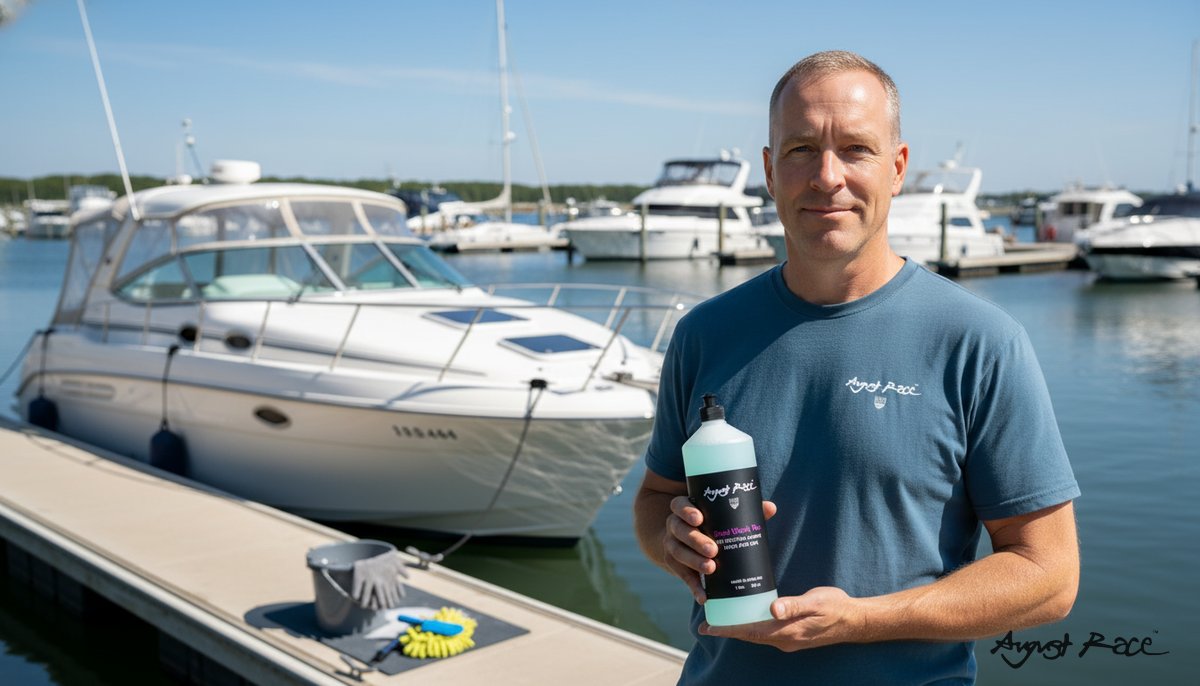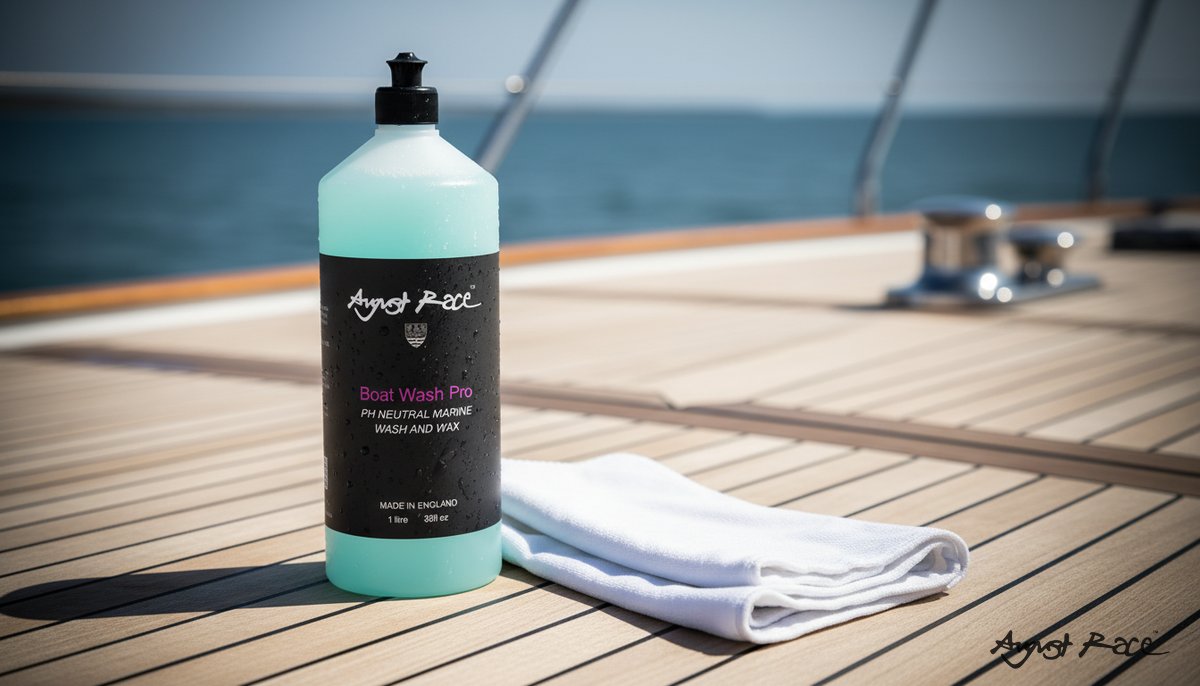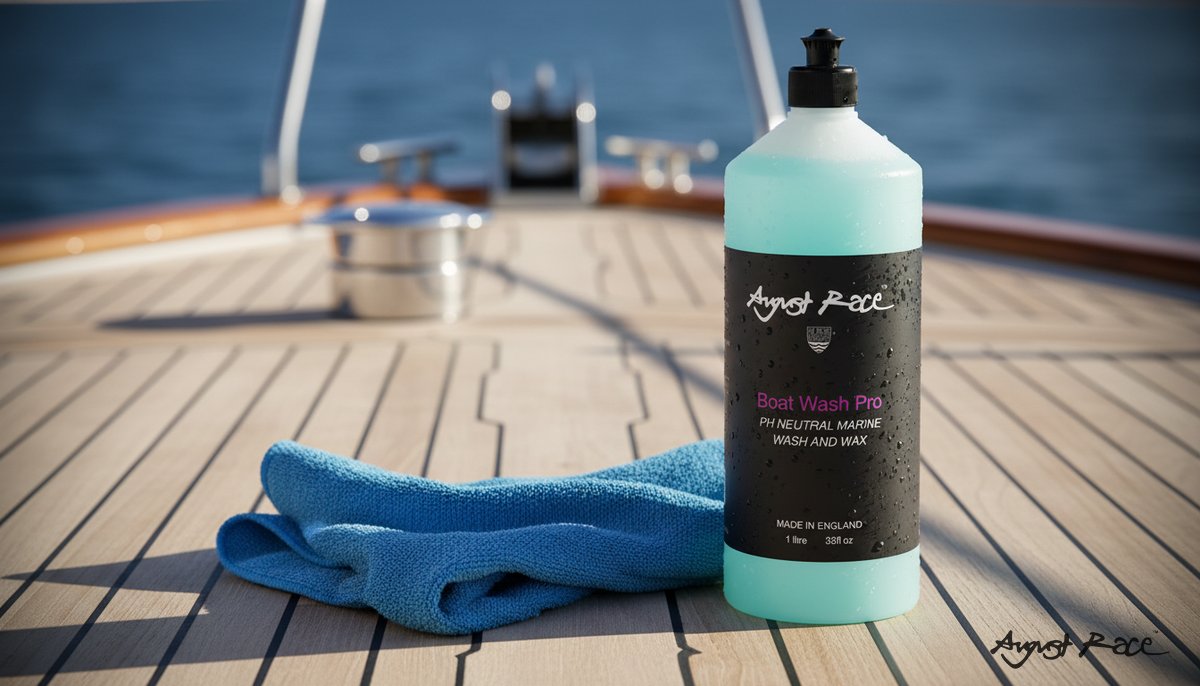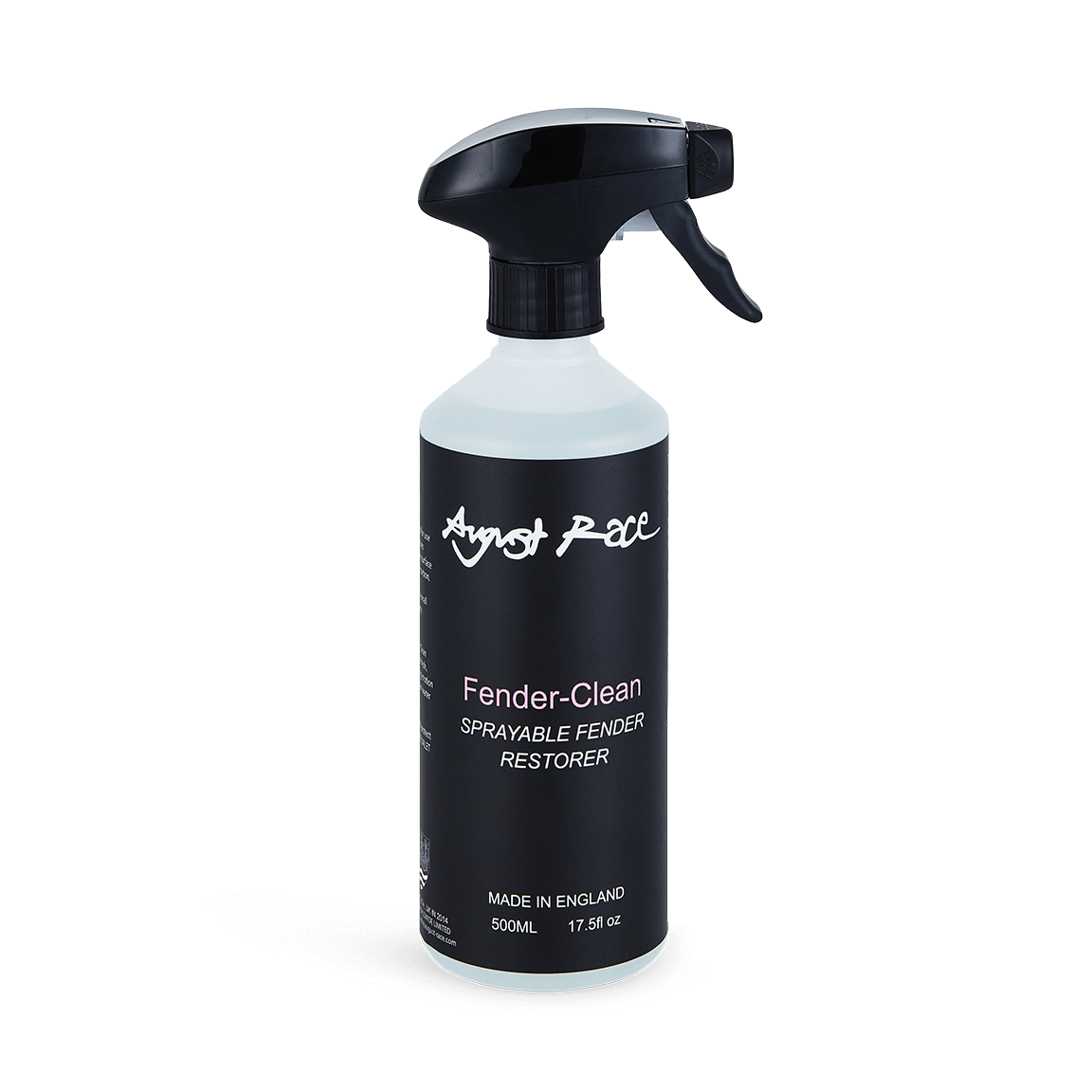Boat Fender Cleaner: Technical Guide to August Race Fender Clean
Marine fenders fail long before their cores wear out. In the field, I’ve been called to investigate “mysterious” fender degradation that turned out to be basic chemistry: salt crystals packed into micro-pores, binding grime and biofilm, and acting like sandpaper every time the fender flexed. A purpose-built boat fender cleaner isn’t just about appearance; it’s a maintenance control that protects docking operations and hull coatings.
When fenders carry salt and marine grime, they transfer abrasive particles to lines and topside gelcoat, increase chafe, and even compromise paint systems. Cleaning is the first, lowest-cost step in preventative maintenance for PVC, rubber, and foam fenders. In this guide, we’ll break down the chemistry behind salt and grime, define selection criteria for a marine grime remover, and walk through a technician-grade procedure -- using August Race Fender Clean as the example solution throughout.
Why fender maintenance matters to a marine technician
On a recent service call, two inflatable PVC fenders were “mysteriously” wearing flat on one face. Under magnification, the surface showed salt crystallization embedded in micro-porosities. Those crystals trapped hydrocarbons and biofilm from the marina, turning that face into a cutting compound. Each berthing cycle accelerated abrasion and heat buildup.
From a risk perspective, neglected fenders:
- Increase line wear and chafe against fairleads and cleats.
- Transfer grit to hull coatings, dulling gelcoat and abrading paint.
- Hide developing cracks and crazing until structural failure occurs.
Cleaning with a fit-for-purpose boat fender cleaner is preventive maintenance. It removes salt, film, and oils that drive abrasion and chemical attack. Done correctly, it extends service life across common fender materials (PVC, rubber, closed-cell foam) and reduces unplanned replacements.
From that incident lens, here’s the specific chemistry and material interactions that make salt and grime so destructive -- and how to select a cleaner that solves them without harming the substrate.
The science of salt, grime, and fender materials
Salt crystallization is not just residue. As sea water dries, salts recrystallize and wedge into micro-porosities in PVC and rubber skins. Those crystals then:
- Attract moisture, keeping surfaces damp and promoting biofilm.
- Bind airborne hydrocarbons (diesel mist, exhaust soot) and fine silicates.
- Act as micro-abrasives whenever the fender flexes under load.
Material differences matter:
- Inflatable PVC: Susceptible to solvent-induced swelling and stress cracking if exposed to aggressive cleaners. Sensitive to strong alkali over time.
- Solid rubber (EPDM, nitrile blends): Chemically robust but can embrittle with strong oxidizers and swell with aromatic solvents.
- Closed-cell foam with protective skins: Skins resist light alkali but can delaminate if harsh solvents creep at seams.
Technicians watch for failure modes like:
- Abrasion and flattening on contact faces.
- Crazing/micro-cracking from chemical stress.
- Delamination of skins or bonded seams.
- Surface embrittlement leading to brittle fracture in cold.
We need a cleaning approach that provides effective salt removal fenders and lifts adhered grime without driving solvents into polymers or increasing long-term embrittlement risk.
What to look for in a professional-grade fender cleaner
Choosing an eco-friendly fender cleaner isn’t marketing -- it’s materials engineering and site compliance.
Key selection criteria:
- pH range: Neutral to mildly alkaline typically balances soil removal with polymer safety. Ultra-strong alkali can haze plastics or degrade rubber binders.
- Surfactant system: Non-ionic surfactants wet out contaminated surfaces and lift oils without attacking plasticizers. They also rinse cleanly, minimizing residue.
- Chelating/sequestering agents: Bind magnesium/calcium salts to dissolve crystallization and prevent re-deposit during rinse. For salt removal fenders and stubborn hydrocarbon soils, prioritize formulations with chelators and non-ionic surfactants.
- Solvent limits: Avoid aggressive aromatic or chlorinated solvents that swell PVC and degrade elastomers. If present, keep to low-VOC, polymer-safe carriers.
- Corrosion inhibitors: Protect adjacent stainless and aluminum hardware during dwell.
- Biodegradability and toxicity profile: Essential for marina discharge rules and crew safety.
Compatibility checks before full deployment:
- Review the SDS/technical datasheet for material compatibility notes.
- Patch test in a small, inconspicuous area. Look for swelling, whitening, tackiness, or gloss change after clean-rinse-dry.
- Confirm rinse-ability. Residual detergent can attract soil and impact hull coatings nearby.
With those requirements in mind, here’s how August Race Fender Clean maps to technician needs.
August Race Fender Clean: formulation and compatibility breakdown
August Race Fender Clean is positioned as a professional marine grime remover for fenders, designed to loosen salt, oils, and biofilm while remaining material-safe and easy to rinse. At a high level, cleaners in this class typically employ:
- Non-ionic surfactants for effective wetting and soil lift without attacking plasticizers in PVC or rubber.
- Chelating agents to complex salt ions and dislodge crystallization.
- Controlled pH to balance cleaning power and substrate protection.
- Low-VOC carriers and corrosion inhibitors to be equipment- and marina-friendly.
Always consult the SDS for exact composition and handling guidance. For technicians, the important point is performance-by-design: wet-out, lift, suspend, and rinse without swelling polymers or leaving residue.
On compatibility, the product is intended for common fender materials such as inflatable PVC and rubber elastomers, and for closed-cell foam skins when used as directed. Best practice is to:
- Conduct a patch test on PVC, nitrile, EPDM, or foam skins.
- Compare after-rinse tactile feel and sheen to baseline.
- Inspect 24 hours later for any delayed swelling or tack.
Safety and environmental posture matter dockside. August Race Fender Clean is marketed for marina use with an emphasis on low VOC and biodegradable ingredients. For many operators evaluating a non-toxic fender restorer profile, the combination of rinse-ability and material safety is what unlocks in-slip cleaning under typical marina guidelines. Verify local rules and the SDS to confirm applicability at your site.
If you also need a hull washdown during turnaround, pair your process with August Race Boat Wash Pro to avoid cross-contaminating fenders with harsher cleaners used on topsides.
Step-by-step: how to remove salt buildup and grime from boat fenders
If you’ve been asked how to clean salt buildup on boat fenders quickly and safely, use the following procedure. It scales from single fenders to fleet cleaning.
Pre-checks and setup
- Inspect and record: Note material type (PVC, rubber, foam), visible damage, seam condition, and any hardened salt or hydrocarbon staining. Photograph before/after for records.
- Patch test: Apply a small amount of August Race Fender Clean to an inconspicuous area. Agitate lightly, rinse, and inspect after drying.
- PPE: Nitrile gloves, eye protection, and non-slip footwear. Use a mask if atomizing with a foam sprayer.
- Tools: Soft bristle brush, microfiber towels, low-pressure freshwater source (avoid high PSI), optional foam sprayer or pump-up sprayer.
- Containment: Work over a designated wash bay or use portable berms/socks to avoid runoff to storm drains where required.
Application and agitation
- Pre-rinse: Use low-pressure freshwater to dissolve loose salt and cool the surface. Keep the nozzle at an angle to avoid driving salts deeper.
- Apply cleaner: Spray August Race Fender Clean evenly. For heavy contamination, allow a dwell time of 2–4 minutes. Do not allow to dry.
- Agitation technique:
-
PVC inflatables: Use soft bristles in overlapping passes. Avoid aggressive scrubbing on logos and seams.
-
Rubber/EPDM: Moderate pressure with soft to medium bristle. Focus on contact flats where salt plates form.
-
Foam skins: Light agitation only; protect seam edges.
-
- Mechanical assist: A foam sprayer helps hold the chemistry in place on vertical surfaces. For stubborn hydrocarbon staining, a second application with extended dwell can be more effective than more force.
Rinse, neutralize (if needed), and dry
- Rinse thoroughly: Use low-pressure freshwater, working top-to-bottom. The goal is to flush dissolved salts and suspended soils off the surface, not blast them in.
- Check feel: After rinse, the surface should feel clean, not tacky. Repeat application on remaining hotspots.
- Neutralization: Not typically required with neutral/mild cleaners. If you’ve used any alkaline pre-treatment elsewhere, finish with a water rinse until runoff is clear.
- Drying and storage: Wipe down with microfiber. Store fenders out of direct sun when possible, and avoid stacking wet fenders to prevent imprinting and recontamination.
Using this sequence, you can remove grime from marine fenders efficiently while keeping substrates intact. For highly contaminated surfaces, two light cycles often beat one aggressive pass.
Pro tip: For UV protection on inflatable tubes after cleaning, consider a dedicated coating such as LR Sealer UV on compatible RIB tubes; keep chemistry off fender lines and adjacent coatings during application.
Performance, longevity, and maintenance intervals -- technician metrics
To quantify your process, measure:
- Salt removal efficacy: Conduct a simple before/after conductivity swab test on rinse water or use chloride test strips on the surface film.
- Visible soil reduction: Standardize before/after photos in consistent lighting and rate on a simple 1–5 scale.
- Time-to-clean: Record labor minutes per fender by soil category (salt plate, biofilm, hydrocarbon).
Recommended inspection and cleaning intervals vary by environment:
- Open-coast moorings: Inspect weekly; clean every 2–4 weeks depending on spray exposure.
- Busy marinas: Inspect biweekly; clean monthly or after heavy rain-dry cycles that accelerate crystallization.
- Estuaries/brackish: Inspect biweekly; clean monthly, watching for organic film buildup.
Regular use of a compatible boat fender cleaner reduces abrasive wear, keeps surfaces supple, and helps you catch seam issues before they become failures. Tie your schedule to operating hours and docking frequency rather than the calendar alone.
Safety, environmental, and regulatory considerations for marina use
Choosing an eco-friendly fender cleaner is also about compliance.
- PPE and handling: Follow SDS guidance. Wear gloves and eye protection; avoid atomizing in windy conditions.
- Containment: Use designated washdown areas or portable containment. Prevent run-off to storm drains unless your site permit allows it.
- Discharge rules: Many marinas permit in-slip cleaning with biodegradable, low-toxicity products if you minimize runoff and rinse with freshwater sparingly. Confirm local rules.
- Documentation: Keep the SDS on file, track lot numbers for traceability, and note application dates in the vessel’s maintenance log. This helps with audits and client transparency.
If your operation requires a non-toxic fender restorer profile, verify biodegradability and toxicity statements against current SDS language and local discharge permits.
How to integrate August Race Fender Clean into your maintenance workflow
A structured pilot prevents surprises and builds confidence.
- Pilot protocol: Select a representative set of fenders (PVC, rubber, foam skin). Baseline condition with photos and, if available, simple chloride tests. Define success criteria (appearance rating, time-to-clean, absence of tackiness or gloss change after 24 hours).
- Field checklist: Record dwell time, agitation method, rinse volume, and crew feedback on ease-of-use.
- Stocking guidance: For small fleets, keep single-bottle or 5L packs near washdown stations. Yards with high throughput may prefer 20L containers with labeled secondary bottles and dilution stations if applicable.
- Crew training: Emphasize patch testing, controlled dwell (never let chemistry dry), seam protection on foam skins, and documenting any anomalies.
When your team can consistently hit your defined outcomes, promote the procedure to your standard maintenance plan for the “best cleaner for dirty boat fenders” use case.
Case studies: tech-approved results from live marina trials
Below are two field-style scenarios you can adapt for your own trials. They outline what to measure and observe rather than promising universal outcomes.
-
Scenario 1 -- Inflatable PVC with heavy salt plate and grit:
-
Condition: Visible salt plates, matte film, gritty feel on the contact face.
-
Method: Pre-rinse, apply August Race Fender Clean, 3-minute dwell, soft-bristle agitation, thorough rinse, repeat on hotspots.
-
Technician observations to capture: Ease of lifting salt without aggressive scrubbing, retention of gloss, no seam whitening or tackiness after 24 hours, reduced grit transfer to lines.
-
-
Scenario 2 -- Closed-cell foam fenders with hydrocarbon staining:
-
Condition: Diesel mist and light soot embedded in surface microtexture.
-
Method: Light foam application, extended dwell within wet edge, gentle agitation focused away from seam edges, controlled rinse.
-
Technician observations to capture: Visible reduction in staining, preserved surface texture, no delamination at edges, improved tactile cleanliness (no oily feel).
-
Many yards find that standardizing pictures, simple conductivity/chloride checks, and a time log makes performance transparent and repeatable across crews.
Get a sample and technical datasheet for August Race Fender Clean
If you need an eco-friendly fender cleaner that aligns with marina practices and technician workflows, request a sample of August Race Fender Clean. Ask for the technical datasheet and SDS so you can verify pH range, material compatibility notes, and handling guidance.
- Schedule a site demo or run a pilot using the metrics above.
- Choose procurement options that fit your throughput: single-bottle trials for small crews, 5L for routine use, or 20L for yard operations.
- For bulk orders or training requests, use the contact channel on the product page or browse August Race products.
A short, well-documented trial usually answers the “fit” question faster than any brochure.
FAQ: technical answers to common cleaning questions
How to clean salt buildup on boat fenders safely without damaging PVC or rubber?
Pre-rinse with low-pressure freshwater, apply August Race Fender Clean evenly, allow a short dwell, then agitate with a soft brush and rinse thoroughly. Keep the nozzle at an angle to flush salts off the surface and avoid long dwell on seams or logos; always patch test first.
What is the best cleaner for dirty boat fenders with hydrocarbon and biofilm stains?
Use a boat fender cleaner with non-ionic surfactants and chelating agents that can lift oils and dissolve salt film without swelling polymers. August Race Fender Clean is designed for those soils and rinses cleanly to reduce re-deposit; let it dwell briefly and use light, repeated passes on stubborn spots.
Is there a non-toxic fender restorer safe for marina discharge rules?
Look for an eco-friendly fender cleaner that is biodegradable and low in VOCs, then confirm with your marina’s discharge policy and the product SDS. August Race Fender Clean is marketed for marina use; verify local requirements and use containment where needed to manage runoff.
A well-selected marine grime remover does more than shine fenders -- it protects berthing gear, hull coatings, and budgets. By selecting a purpose-built boat fender cleaner like August Race Fender Clean, following the compatibility checks, and standardizing your process, you’ll cut abrasion risk, speed up turnarounds, and extend fender service life across your fleet.
About the Author
August Race Team
The August Race professional team brings decades of marine industry expertise and product development knowledge.
Get Expert Tips
Subscribe for marine care insights and product updates from industry professionals.
No spam. Unsubscribe anytime.
You May Also Like

Best Boat Wash for Marinas: August Race Boat Wash Pro
Scale a fast, compliant boat wash across busy slips. See how August Race Boat Wash Pro handles salt, stains, and algae removal with marina-ready efficiency.

Clean Salt off Painted Boats | Biodegradable Boat Wash
Learn how to remove salt from painted boats using a marine paint cleaner and biodegradable boat wash for streak free results. Steps, tips, and FAQs.

Remove Salt Buildup on Gelcoat | Boat Wash Pro Guide
Stop salt haze on gelcoat the smart way. Use August Race Boat Wash Pro for gentle, streak-free, biodegradable cleaning and lasting gloss.
